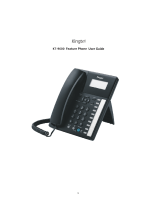
Installation Manual 13
2.6.2 Parallel Connection of the Extensions .....................................................................80
2.6.3 Extra Device Port (XDP) Connection.......................................................................81
2.6.4 Digital Extra Device Port (Digital XDP) Connection.................................................82
2.6.5 First Party Call Control CTI Connection...................................................................84
2.7 Connection of DECT Portable Stations................................................................85
2.7.1 Overview..................................................................................................................85
2.7.2 Procedure Overview ................................................................................................87
2.7.3 Site Planning............................................................................................................89
2.7.4 Before Site Survey ...................................................................................................93
2.7.5 Site Survey Using the KX-TD7590...........................................................................96
2.7.6 After Site Survey......................................................................................................99
2.7.7 Connecting the Cell Station to the Hybrid IP-PBX.................................................100
2.7.8 Wall Mounting ........................................................................................................106
2.8 Connection of 2.4 GHz Portable Stations..........................................................108
2.8.1 Overview................................................................................................................108
2.8.2 Procedure Overview ..............................................................................................109
2.8.3 Site Planning..........................................................................................................111
2.8.4 Before Site Survey.................................................................................................115
2.8.5 Site Survey.............................................................................................................117
2.8.6 After Site Survey....................................................................................................120
2.8.7 Connecting the Cell Station to the Hybrid IP-PBX.................................................121
2.8.8 Wall Mounting ........................................................................................................126
2.9 Connection of Doorphones and Door Openers ................................................128
2.9.1 Connection of Doorphones and Door Openers .....................................................128
2.10 Connection of Peripherals ..................................................................................134
2.10.1 Connection of Peripherals......................................................................................134
2.11 Auxiliary Connection for Power Failure Transfer..............................................138
2.11.1 Auxiliary Connection for Power Failure Transfer.....................................................138
2.12 Starting the Hybrid IP-PBX..................................................................................140
2.12.1 Starting the Hybrid IP-PBX ....................................................................................140
3 Guide for the KX-TDA Maintenance Console ........................... 143
3.1 Overview...............................................................................................................144
3.1.1 Overview................................................................................................................144
3.2 Connection...........................................................................................................145
3.2.1 Connection.............................................................................................................145
3.3 Installation of the KX-TDA Maintenance Console.............................................147
3.3.1 Installing and Starting the KX-TDA Maintenance Console ....................................147
3.3.2 Structure of the KX-TDA Maintenance Console ....................................................151
3.3.3 Hybrid IP-PBX Configuration .................................................................................152
3.3.4 Hybrid IP-PBX Maintenance..................................................................................153
4 Troubleshooting.......................................................................... 155
4.1 Troubleshooting...................................................................................................156
4.1.1 Installation..............................................................................................................156
4.1.2 Connection.............................................................................................................157
4.1.3 Operation...............................................................................................................159
4.1.4 Using the Reset Button..........................................................................................161
4.1.5 Troubleshooting by Error Log.................................................................................163
Index .................................................................................................. 171























